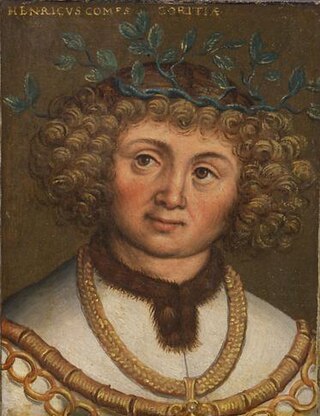Life
Otto VII was the only son of Count Nicholas II of Tecklenburg and his wife Anna Elisabeth, a daughter of Count Frederick III of Moers. In 1426, he succeeded his father as Count of Tecklenburg. Like his father, he fought many feuds, in an attempt to win back some of the territories his father had lost. The attempt failed, and pushed his county deeper into debt. This accelerated the decline of the county.
He died in 1450, and was succeeded by his eldest son, Nicholas III.

Bentheim-Tecklenburg was a German county, later principality, based in the region around Tecklenburg in northern North Rhine-Westphalia, Germany.
Bentheim-Lingen was a county seated in Lingen in Germany. Bentheim-Lingen emerged as a partition of Bentheim-Tecklenburg in 1450, and was absorbed by Spain in 1555. Over the next century, ownership of Bentheim-Lingen passed between Spain and Nassau-Orange, before being annexed by Prussia 1702.

Gerhard VI, Count of Oldenburg was a Count of Oldenburg and regent of Bad Zwischenahn in 1440–1482.

Essen Abbey was a community of secular canonesses for women of high nobility that formed the nucleus of modern-day Essen, Germany.

The House of Andechs was a feudal line of German princes in the 12th and 13th centuries. The counts of Dießen-Andechs obtained territories in northern Dalmatia on the Adriatic seacoast, where they became Margraves of Istria and ultimately dukes of a short-lived imperial state named Merania from 1180 to 1248. They were also self-styled lords of Carniola.

Bogislaw X of Pomerania, the Great, was Duke of Pomerania from 1474 until his death in 1523.
George I, Prince of Anhalt-Dessau, was a German prince of the House of Ascania and ruler of the principality of Anhalt-Dessau. He was the second son of Sigismund I, Prince of Anhalt-Dessau, by his wife Judith, daughter of Gebhard XI, Count of Querfurt.
Eric I, Duke of Brunswick-Grubenhagen nicknamed the winner, ruled the Principality of Grubenhagen, a part of the Duchy of Brunswick-Lüneburg.

John II of Nassau-Wiesbaden-Idstein was a son of Adolph II, Count of Nassau-Wiesbaden-Idstein and his wife Margarete of Baden, a daughter of Margrave Bernard I, Margrave of Baden-Baden en Anna of Oettingen. After his father's death in 1426, he ruled Nassau-Wiesbaden and Nassau-Idstein.
Nicholas I, Count of Tecklenburg, also known as Nicholas III of Schwerin, was a German noble in the Holy Roman Empire.

Henry VI (1376–1454), a member of the House of Gorizia, ruled as Count of Gorizia from 1385 until his death. He was also Count Palatine of Carinthia, governor of Belluno-Feltre and Landeshauptmann of Carniola. Through his first marriage with Elizabeth of Cilli, he was the brother-in-law of Sigismund of Luxembourg, Holy Roman Emperor and King of Hungary.
Count Jobst II of Hoya ruled the County of Hoya from 1511 until his death.
Otto VI, Count of Tecklenburg was the only son of Count Nicholas I and his wife, Helena of Oldenburg-Wildeshausen-Alt-Bruchhausen. In 1367, he succeeded his father as count of Tecklenburg-Ibbenbüren and count of Lingen and Cloppenburg. In 1376, he became pledge holder of Iburg.
Otto IV, Count of Waldeck at Landau was the third and last ruling count of the elder Waldeck-Landau line. He was the grandson of Count Adolph III, who had founded the elder Waldeck-Landau line in 1387 and was the third and only surviving son of Count Otto III and his wife Anna of Oldenburg. His elder brothers John and Henry had died unmarried and childless in 1431 and 1438 respectively.
Jobst I, Count of Hoya was the ruling Count of Upper Hoya from 1466 to 1503 and Count of Hoya from 1503 until his death.
Nicholas II of Tecklenburg was the ruling Count of Tecklenburg from 1388 until his death.
Eric I, Count of Hoya (1370-1426) was a German nobleman. He was the ruling Count of Upper Hoya from 1377 until his death.
The County of Diepholz, that was first known as the Lordship of Diepholz, was a territory in the Holy Roman Empire in the Lower-Rhenish-Westphalian Circle. It was ruled by the Noble Lords, later Counts, of Diepholz from the late tenth century until 1585, when it was mostly incorporated into the Duchy of Brunswick-Lüneburg.
This page is based on this
Wikipedia article Text is available under the
CC BY-SA 4.0 license; additional terms may apply.
Images, videos and audio are available under their respective licenses.






